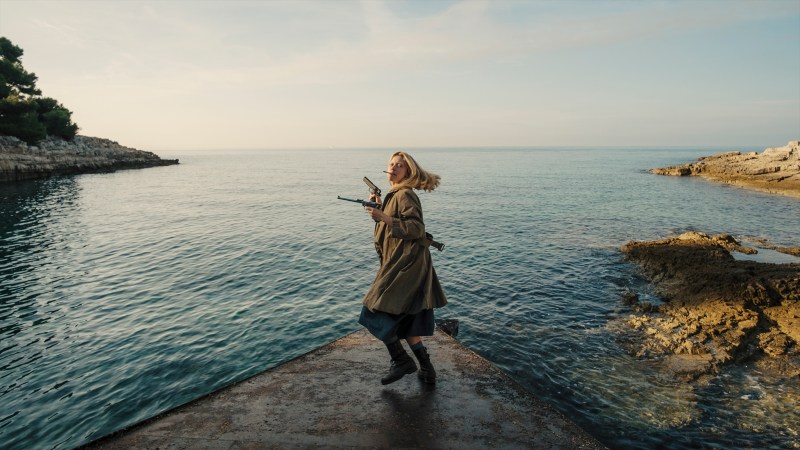This is the third piece in the Sundance Film Festival 2021 series by Julie Fukunaga and Olivia Popp. Follow along for coverage of films from Sundance’s reimagined virtual festival.
Content warning: The discussion of this film touches on issues of sexual violence and abuse.
If any sensory experience remains with you from “Mayday,” it’s the haunting whisper of “Mary … Alpha … Yankee … Delta … Alpha … Yankee” as the stylistic metonym of Karen Cinorre’s feature debut. Replacing the NATO phonetic alphabet’s “M” for “Mike” with “Mary,” a not-so-subtle nod to the film’s core premise of empowerment and friendship between women, “Mayday” is a surrealist exploration of trauma in an inventive form coupled with an impeccably lush aesthetic (with cinematography by Sam Levy). While “Mayday” describes itself as a “feminist fever dream and an ambitious reimagining of a war film,” others have compared the film to Zack Snyder’s “Sucker Punch,” in which the main character, having been committed to a mental institution, copes by imagining herself and her compatriots fighting their way out of a genre-bending, action-fantasy world. “Mayday,” however, also navigates a complex set of narratives on autonomy and conformity that leaves the viewer with difficult questions, satisfying for some but frustrating for others.
Anastasia (Grace Van Patten), nicknamed Ana, is a young woman working at a wedding venue who is implied to be abused and sexually assaulted by her boss. Hearing a disembodied voice whisper out to her (“Mary … Alpha …”), she begins walking toward the kitchen. Upon her apparent attempt to commit suicide by crawling into an oven, she instead she crawls through the oven, following the whisper, and is plunged into an alternate reality. After a mere eight minutes or so in Ana’s “real” life, the wedding venue’s cast of characters is transposed into this alternate reality, a hyper-saturated Themiscyra with a World War I technological aesthetic. The characters, however, aren’t converted via comprehensible one-to-one correlations, reflecting the dreamlike quality of the world warped from Ana’s mind. Upon her arrival, the confident Marsha (Mia Goth) greets Ana and takes her under her wing. She also introduces Ana to her small group, consisting of the stoic Gert (Soko) and the easily frightened Bea (Havana Rose Liu), other young women who have suffered unspecified trauma from men. Marsha, the real-world counterpart of the weepy bride who seeks Ana’s help in the bathroom, is a stark contrast to the headstrong girl group leader Marsha, who has her bicurious, intimate moments with Ana as she teaches the latter to swim and shoot a sniper rifle.

“Mayday” thrives on its vibrant, sweeping cinematography, making full use of the picturesque Croatian coastline in which it was shot. Put simply, it’s a stunning film — arguably enough to just bask in the visuals at times. The siren-esque premise of “Mayday,” in which young women coolly lure young men to their deaths by sending out mayday calls to their ships, may lead viewers to classify it as a revenge film. Yet “Mayday” doesn’t quite follow in the footsteps of “Promising Young Woman,” nor is the dreamlike world exclusively a place in which Ana is thrust to work out her unresolved trauma.
Initially confused over her newfound home, Ana begins to learn the rules of the land as well as those of the group’s dynamics, embracing her ability to seek retribution on those who wronged her. When she gains more independence and begins to think for herself, though, she garners the wrath of Marsha, who embodies what viewers have been calling the “girlboss” archetype of the film. The film’s critique of gender essentialism is embodied in the militaristic, self-serving white feminist attitude of Marsha, who is on a mission to kill all men who set foot on the group’s turf. Nonetheless, the difficulty for the group is that Marsha carries an aplomb that is almost too alluring to pass up, in part a significant credit to Goth’s performance; Goth is by far the standout of “Mayday,” ricocheting from the effortlessly cool, clever leader of the gang to the wily and out-for-blood leader who takes no prisoners. But “Mayday” refuses to fully endorse militant white feminism — that of Marsha’s war on men that carries the energy of “Jennifer’s Body” (“You’re killing people!” “No, I’m killing boys.”). Rather, Ana is forced to navigate the liminal space between assimilating into this new environment and taking what she is told for granted versus retaining her autonomy and not caving to the temptations of Marsha’s ideology.
Admittedly, “Mayday” grows thinnest at its climax, resorting to technobabble to get Ana out of the surrealist world after she decides to leave and confront her harsh reality — while the others stay and acknowledge that they will no longer exist upon her departure. With something like Lynch’s acclaimed “Mulholland Drive” as cinema’s point of comparison for surrealist film, it’s easy to harp on the occasional incoherence of “Mayday” as a major fault of the film. Nonetheless, accepting that “Mayday” doesn’t have all the answers is perhaps the first step to embracing the film’s provoking propositions. Must it have a clear-cut moral or message? It need not be that didactic — nor claim that Ana must return to reality rather than continue in this pseudo-utopic liberational world of girl power. Looking beyond its veneer of what it appears to preach, “Mayday” is an impressive debut by Cimorre and worth the watch. It is also a film, still seeking distribution, whose visuals are extraordinarily deserving of a theatrical release if the pandemic ever lets up.
